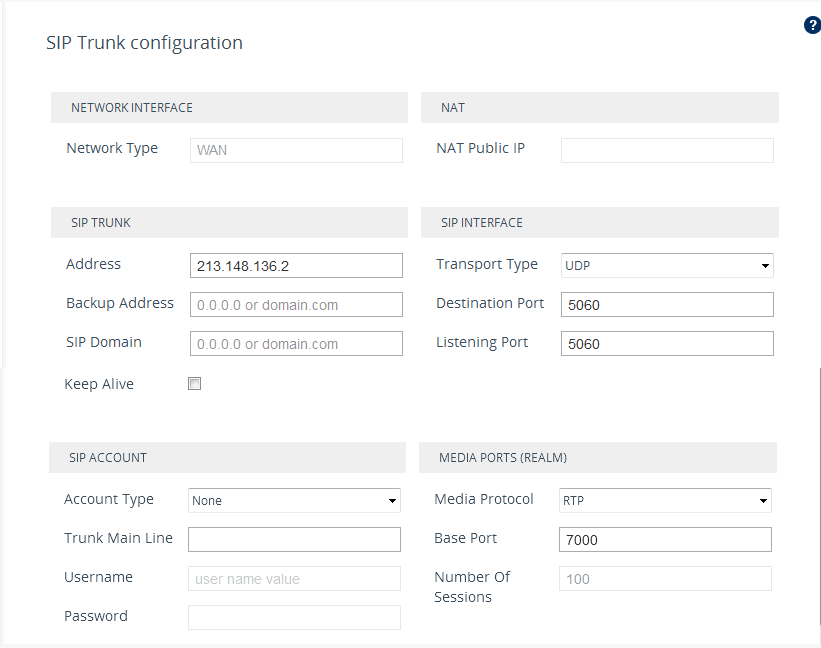SIP Trunk Page
The SIP Trunk wizard page configures the SIP Trunk settings.

The following fields are read-only:
|
■
|
'Network Type': Displays the IP network interface for communicating with the SIP Trunk. |
|
■
|
'NAT Public IP': Displays the public IP address (of the Enterprise router) for communicating with the SIP Trunk. The field is applicable only when the device is connected to a router that performs NAT. Note that the Enterprise router must be configured to "port forward" all VoIP traffic from the SIP Trunk (located on the WAN) to the device. The exact port forwarding configuration is displayed on the Conclusion page and consists of the device's address, SIP listening port (e.g. 5060) and a range of media ports defined below (e.g. 6000-6999). |
|
➢
|
To configure SIP Trunk settings: |
|
1.
|
Under the SIP Trunk group, configure the following: |
|
●
|
'Address': Configures the IP address or hostname of the SIP Trunk. |
|
●
|
'Backup Address': (Optional) Configures the backup IP address or hostname of the SIP Trunk. |
|
●
|
'SIP Domain': Configures the SIP domain name for communicating with the SIP Trunk. The domain name is used in the following SIP message headers: |
|
◆
|
Outbound calls: Request-URI and To headers |
|
◆
|
Inbound calls: From header |
|
●
|
'Keep Alive': Enables the periodic keep-alive check of multiple SIP Trunk addresses. |
|
2.
|
Under the SIP Interface group, configure the SIP ports and transport type for communicating with the SIP Trunk: |
|
●
|
'Transport Type: Configure the SIP transport type. |
|
●
|
'Destination Port: Configure the SIP port used by the SIP Trunk. |
|
●
|
'Listening Port: Configure the SIP port used by the device for communicating with the SIP Trunk. Note that for the One port: WAN network topology, the device must use different Listening Ports when communicating with the IP PBX and SIP Trunk. |
|
3.
|
Under the Media Ports (Realm) group, configure the media protocol type and ports used by the device for communicating with the IP PBX: |
|
●
|
'Media Protocol': Configure the media protocol type. |
|
●
|
'Base Port': Configure the first media port. |
|
●
|
'Number Of Sessions': Configure the number of required media sessions. For more information on media port ranges and number of sessions, see Configuring RTP Base UDP Port. |
|
4.
|
Under the SIP Account group, configure the device's registration with the SIP Trunk: |
|
●
|
'Account Type': Configure whether the device must perform registration or authentication with the SIP Trunk (None, Registration or Authentication). |
|
●
|
'Trunk Main Line': Configure the "leading number" assigned by the SIP Trunk. Many SIP Trunks use the same value for Trunk Main Line and Username parameters. |
|
●
|
'Username': Configure the SIP authentication username (as provided by the SIP Trunk provider). |
|
●
|
'Password': Configure the SIP authentication password (as provided by the SIP Trunk provider). |
The password cannot be configured with wide characters.
